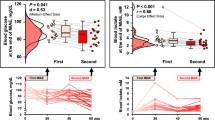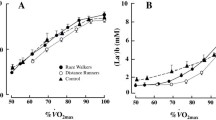Abstract
This study examined the association of blood lactate concentration [La] and heart rate (HR) with ratings of perceived exertion (RPE) during 60 min of steady workload cycling. Physically active college-aged subjects (n=14) completed an exhaustive cycling test to determine VO2 peak and lactate threshold (2.5 mmol l−1). Subjects then cycled for 60 min at the power output associated with 2.5 mmol l−1 [LA]. HR, [LA], RPE-overall, RPE-legs and RPE-chest were recorded at 5, 10, 20, 30, 40, 50 and 60 min. The 60-min trials were below maximal lactate steady state, with peak lactate concentration occurring at 20 min after which [LA] declined. The 20-min point was therefore considered pivotal, and data at other points were compared to this time point. Repeated measures ANOVA with simple contrasts (alpha=0.05) showed (a) [LA] at 40, 50 and 60 min was significantly lower than at 20 min, (b) RPE-O and RPE-L were significantly greater at 30, 40, 50 and 60 min than at 20 min, (c) RPE-C was significantly greater at 40, 50 and 60 min than at 20 min, and (d) HR was significantly greater at 30, 40, 50 and 60 min than at 20 min. Significant (P<0.05) positive correlations were found between HR and RPE-O (r=0.43), RPE-L (r=0.48) and RPE-C (r=0.41) while correlations for [LA]-HR (r=0.13) and [LA]-RPE (RPE-O: r=−0.11, RPE-L: r=0.01, RPE-C: r=−0.06) were weak and non-significant. There is a dissociation of RPE and [LA] owing to RPE drift and lactate kinetics in longer duration sub-maximal exercise. Apparently, [LA] is not a strong RPE mediator during extended cycling.



Similar content being viewed by others
References
Allen PD, Pandolf KB (1977) Perceived exertion associated with breathing hyperoxic mixtures during submaximal work. Med Sci Sport 9:122–127
American College of Sports Medicine (2000) Guidelines for exercise testing and prescription, 6th edn. Williams and Wilkins, Baltimore
Ceci R, Hassmen P (1991) Self-monitored exercise at three different RPE intensities in treadmill vs. field running. Med Sci Sport Exerc 23:732–738
Coyle EF, Gonzalez-Alonso J (2001) Cardiovascular drift during prolonged exercise: new perspectives. Exerc Sport Sci Rev 29:88–92
Demello JJ, Cureton KJ, Boineau RE, Singh MM (1987) Ratings of perceived exertion at the lactate threshold in trained and untrained men and women. Med Sci Sport Exerc 19:354–362
Dunbar CC, Robertson RJ, Baun R, Blandin MF, Metz K, Burdett R, Goss FL (1992) The validity of regulating exercise intensity by ratings of perceived exertion. Med Sci Sport Exerc 24:94–99
Ekblom B, Goldbarg AN (1971) The influence of physical training and other factors on the subjective rating of perceived exertion. Acta Physiol Scand 83:399–406
Eston RG, Davies BL, Williams JG (1987) Use of perceived effort ratings to control exercise intensity in young healthy adults. Eur J Appl Physiol 56:222–224
Garcin M, Billat V (2001) Perceived exertion scales attest to both intensity and duration. Percept Mot Skills 93:661–667
Glass SC, Knowlton RG, Becque MD (1992) Accuracy of RPE from graded exercise to establish exercise training intensity. Med Sci Sport Exerc 24:1303–1307
Green JM, Crews TR, Bosak AM, Peveler WW (2003) Overall and differentiated ratings of perceived exertion at the respiratory compensation threshold: effects of gender and mode. Eur J Appl Physiol 89:445–450
Hetzler RK, Seip RL, Boutcher SH, Pierce E, Snead D, Weltman A (1991) Effect of exercise modality on ratings of perceived exertion at various lactate concentrations. Med Sci Sport Exerc 23:88–92
Maud PJ, Foster C (1995) Physiological assessment of human fitness. Human Kinetics, Champaign
Mihevic PM (1981) Sensory cues for perceived exertion: a review. Med Sci Sport Exerc 13:150–163
Moreau KL, Whaley MH, Ross JH, Kaminsky LA (1999) The effects of blood lactate concentration on perception of effort during graded and steady state treadmill exercise. Int J Sport Med 20:269–274
Noble BJ, Borg G, Jacobs I, Ceci R, Kaiser P (1983) A category-ratio perceived exertion scale: relationship to blood and muscle lactates and heart rate. Med Sci Sport Exerc 15:523–529
Pollock ML, Schmidt DH, Jackson AS (1980) Measurement of cardiorespiratory fitness and body composition in the clinical setting. Clin Ther 6:12–27
Robertson RJ (1982) Central signals of perceived exertion during dynamic exercise. Med Sci Sport Exerc 14:390–396
Robertson RJ, Noble BJ (1997) Perception of physical exertion: methods, mediators, and applications. Exerc Sport Sci Rev 25:407–452
Robertson RJ, Falkel JE, Drash AL, Swank AM, Metz KF, Spungen SA, LeBoeuf JR (1986) Effect of blood pH on peripheral and central signals of perceived exertion. Med Sci Sport Exerc 18:114–122
Robertson RJ, Moyna NM, Sward KL, Millich NB, Goss FL, Thompson PD (2000) Gender comparison of RPE at absolute and relative physiological criteria. Med Sci Sport Exerc 32:2120–2129
Seip RL, Snead DS, Pierce EF, Stein P, Weltman A (1991) Perceptual responses and blood lactate concentration: effect of training state. Med Sci Sport Exerc 23:80–87
Stallknecht B, Vissing J, Galbo H (1998) Lactate production and clearance in exercise. Effects of training. A mini-review. Scand J Med Sci Sport 8:127–131
Stoudemire NM, Wideman L, Pass KA, McGinnes CL, Gaesser GA, Weltman A (1996) The validity of regulating blood lactate concentration during running by ratings of perceived exertion. Med Sci Sport Exerc 28:490–495
Utter AC, Kang J, Nieman DC, Williams F, Robertson RJ, Henson DA, Davis JM, Butterworth DE (1999) Effect of carbohydrate ingestion and hormonal responses on ratings of perceived exertion during prolonged cycling and running. Eur J Appl Physiol 80:92–99
Weltman A (1995) The blood lactate response to exercise. Human Kinetics, Champaign
Author information
Authors and Affiliations
Corresponding author
Rights and permissions
About this article
Cite this article
Green, J.M., McLester, J.R., Crews, T.R. et al. RPE-lactate dissociation during extended cycling. Eur J Appl Physiol 94, 145–150 (2005). https://doi.org/10.1007/s00421-004-1311-2
Received:
Accepted:
Published:
Issue Date:
DOI: https://doi.org/10.1007/s00421-004-1311-2




